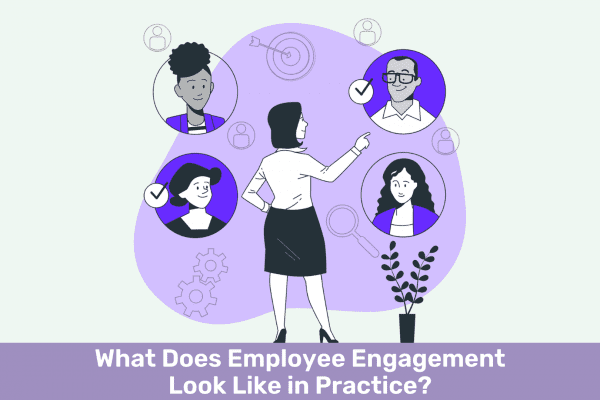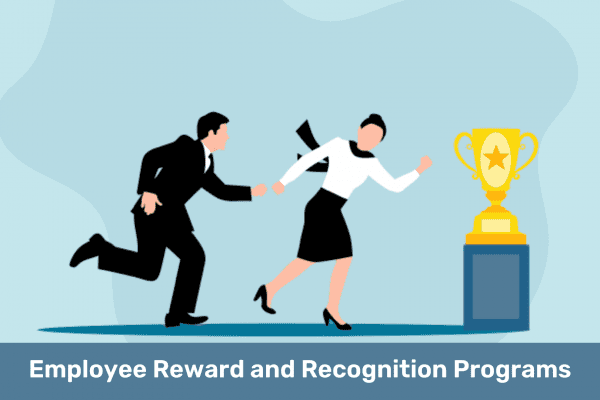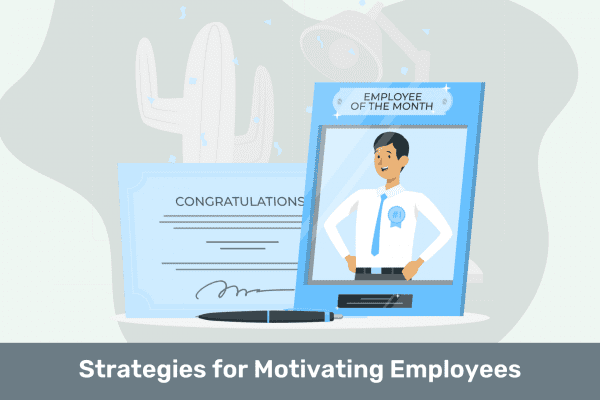Introduction
In 2024, as businesses continue to evolve, the focus on employee engagement ideas has become increasingly crucial. Engaged employees don’t just show up; they bring their best selves to work, significantly boosting both the quality of their output and the workplace environment.
Highlighting the practical impact of engagement, a study by Gallup reveals that highly engaged business units see an 81% difference in absenteeism and a 14% increase in productivity compared to their less engaged peers. These statistics powerfully underscore the importance of effective employee engagement strategies. In this blog, we will explore 52 innovative employee engagement ideas, each designed to foster a workplace where employees feel deeply connected, motivated, and fully appreciated.
Promoting a Flexible Work Environment

Adopting a flexible work environment is essential in today’s evolving workplace. Here are four key strategies to enhance flexibility:
1. Flexible Scheduling:
Implement a policy that allows employees to choose their working hours, catering to their personal commitments and peak productivity times.
2. Remote Work Options:
Provide the option for employees to work remotely, whether it’s full-time, part-time, or as needed. This acknowledges the evolving nature of work-life balance and supports diverse working styles.
3. Compressed Workweeks:
Offer the possibility of a compressed workweek, where employees work longer hours for fewer days. This can lead to increased employee satisfaction and a better work-life balance.
4. Job Sharing Opportunities:
Introduce job sharing for suitable roles, allowing two or more employees to share the responsibilities of one full-time position. This can be particularly appealing to those seeking part-time employment or work-life balance.
These four strategies within the realm of fostering a flexible work environment can significantly contribute to enhanced employee engagement by accommodating various personal and professional needs.
Utilizing Technology for Engagement

Leveraging technology effectively can greatly enhance employee engagement by facilitating better communication, collaboration, and flexibility. Here are four strategic ways to use technology for employee engagement:
5. Collaboration Platforms:
Implement advanced collaboration tools like Slack, Microsoft Teams, or Asana to improve communication and project management. These platforms can help keep remote and in-house teams connected and productive.
6. Employee Engagement Apps:
Utilize apps designed to boost engagement, such as mobile platforms for recognition, feedback, or wellness tracking. These apps can offer an interactive and accessible way for employees to connect with the company culture.
7. Virtual Reality (VR) for Training:
Incorporate VR technology for immersive training experiences. VR can make learning more engaging and memorable, especially for complex or technical subjects.
8. AI-Powered Analytics Tools:
Use AI-driven tools to analyze employee feedback and engagement levels. This technology can provide insights into employee sentiment and help identify areas for improvement.
By integrating these technology-driven strategies, you can enhance employee engagement in a modern and efficient manner, adapting to the evolving expectations of today’s workforce.
Enhancing Professional Development Opportunities

Investing in your employees’ professional growth is a key strategy for boosting engagement. Here are four effective ways to enhance professional development opportunities:
9. Tailored Training Programs:
Develop training programs that are tailored to the specific needs and career goals of your employees. This can include skills training, leadership development programs, or workshops on the latest industry trends.
10. Mentorship Programs:
Establish mentorship programs where employees can learn from experienced colleagues. This not only aids in skill development but also fosters a culture of learning and knowledge sharing within the organization.
11. Career Pathing Sessions:
Regularly hold career pathing sessions to help employees understand their potential career trajectories within the company. This shows your commitment to their long-term growth and development.
12. Educational Assistance:
Offer educational assistance or tuition reimbursement for employees pursuing further education or certifications relevant to their roles. This not only supports their professional development but also brings new skills and knowledge into the organization.
By implementing these professional development strategies, you are not only enhancing the skills of your workforce but also demonstrating a genuine investment in their career growth and satisfaction.
Recognizing and Rewarding Employees

Recognition and rewards are powerful tools for boosting employee engagement. Here are four effective strategies for acknowledging and rewarding your employees:
13. Peer-to-Peer Recognition Programs:
Implement a program where employees can recognize their colleagues for their hard work and achievements. This could be through a dedicated platform or regular team meetings.
14. Performance-Based Bonuses:
Offer bonuses or other financial incentives based on individual or team performance. This not only rewards high achievers but also motivates others to strive for excellence.
15. Employee of the Month/Quarter/Year Awards:
Establish a regular award program to celebrate outstanding employees. This can include not just a title, but also perks like a prime parking spot, a trophy, or a special lunch with company leaders.
16. Customized Rewards:
Personalize rewards based on the individual’s interests or needs, such as extra days off, gift cards to their favorite stores, or tickets to events. Customized rewards show that you pay attention to what matters to your employees.
These strategies for recognizing and rewarding employees can significantly enhance morale and motivation, creating a positive and appreciative work culture.
Promoting Health and Wellness

Incorporating health and wellness into your employee engagement ideas is crucial for promoting a balanced and productive workforce. Here are four strategies to promote health and wellness among your employees:
17. On-Site Fitness Facilities or Memberships:
Provide access to on-site fitness facilities or subsidize gym memberships. Encouraging physical activity not only boosts health but also improves mental well-being and energy levels.
18. Regular Health Screenings:
Organize regular health screenings and wellness check-ups at the workplace. Early detection of health issues can lead to better health outcomes and less absenteeism.
19. Wellness Challenges and Programs:
Implement wellness challenges, such as step-count competitions or healthy eating challenges, as part of your employee engagement ideas. These programs can motivate employees to adopt healthier lifestyles in a fun and engaging way.
20. Mental Health Days and Resources:
Recognize the importance of mental health by offering mental health days off and providing access to mental health resources, such as counseling services or stress management workshops.
By including these health and wellness strategies in your employee engagement ideas, you create an environment that values and supports the overall well-being of your team members.
Building a Culture of Open Communication

A culture of open communication is fundamental to successful employee engagement. Here are four employee engagement ideas focused on enhancing communication within your organization:
21. Regular Town Hall Meetings:
Host town hall meetings where employees can openly discuss company matters, share ideas, and ask questions directly to the management. This transparent approach to communication can significantly boost trust and engagement.
22. Feedback Platforms:
Implement digital platforms where employees can provide anonymous feedback. This can encourage more honest and open communication, especially on sensitive issues.
23. Communication Skill Workshops:
Offer workshops or training sessions to improve interpersonal and communication skills. This can include conflict resolution, effective listening, and assertive communication techniques.
24. Cross-Departmental Meetups:
Organize informal meetups or discussions between different departments. This helps break down silos, promotes understanding of various roles within the company, and promotes a more cohesive work environment.
Incorporating these employee engagement ideas can lead to a more open, transparent, and communicative workplace, which is essential for fostering a sense of belonging and engagement among employees.
Encouraging Team Collaboration and Bonding

Promoting a sense of team spirit and camaraderie is essential in any employee engagement strategy. Here are four employee engagement ideas that focus on enhancing team collaboration and bonding:
25. Team Building Retreats:
Organize retreats or off-site team-building activities. These can range from outdoor adventures to workshops focused on teamwork and collaboration. Such events can significantly strengthen team bonds and improve collaborative efforts.
26. Group Volunteer Projects:
Encourage teams to participate in volunteer projects together. This not only contributes to the community but also allows employees to bond over shared experiences and values outside of the workplace.
27. Cross-Functional Team Challenges:
Set up challenges or projects that require members from different departments to work together. This promotes a deeper understanding of various aspects of the company and encourages cross-departmental collaboration.
28. Social Events and Gatherings:
Regularly scheduled social events, such as team lunches, holiday parties, or happy hours, provide informal settings for employees to interact and build relationships.
By integrating these team collaboration and bonding activities into your employee engagement ideas, you create opportunities for employees to connect on a deeper level, fostering a stronger, more unified workforce.
Supporting Diversity and Inclusion

Incorporating diversity and inclusion into your employee engagement ideas is essential for creating a respectful, open, and collaborative workplace culture. Here are four strategies to enhance diversity and inclusion:
29. Diversity Training Workshops:
Conduct regular workshops and training sessions on diversity, equity, and inclusion. These should aim to educate employees about different cultures, perspectives, and the importance of an inclusive work environment.
30. Inclusive Policy Reviews:
Regularly review company policies to ensure they are inclusive and accommodating to all employees. This includes looking at hiring practices, promotion criteria, and workplace accommodations.
31. Celebration of Cultural Events:
Encourage the celebration of various cultural and historical events within the workplace. This can include organizing events or discussions around significant dates and festivals from different cultures.
32. Employee Resource Groups:
Support the formation of employee resource groups (ERGs) that provide a space for employees from various backgrounds to connect and share their experiences. These groups can also offer valuable insights into company policies and culture.
Implementing these employee engagement ideas focused on diversity and inclusion not only encourages a more welcoming and respectful workplace but also encourages varied perspectives and ideas, enriching the organization as a whole.
Implementing Employee Feedback Mechanisms

Effective employee engagement strategies often hinge on how well a company listens to its employees. Here are four employee engagement ideas centered around implementing robust feedback mechanisms:
33. Regular Employee Surveys:
Conduct frequent and comprehensive surveys to gather employee feedback on various aspects of the workplace. Ensure anonymity to encourage honest and constructive feedback.
34. Suggestion Box System:
Establish a physical or digital suggestion box system where employees can continuously submit ideas and feedback. Regularly review and address these suggestions in management meetings.
35. ‘Open Door’ Policy Reinforcement:
Promote an ‘open door’ policy where employees feel comfortable sharing their concerns and suggestions directly with management or HR, fostering a culture of open communication.
36. Feedback-Oriented Meetings:
Schedule regular meetings, such as town halls or focus groups, specifically designed for discussing feedback and suggestions from employees. This demonstrates a commitment to considering and implementing employee ideas.
These feedback-focused employee engagement ideas are crucial for understanding the needs and concerns of your workforce, enabling you to make informed decisions that improve overall workplace satisfaction and engagement.
Community Involvement and Corporate Social Responsibility

Integrating community involvement and corporate social responsibility (CSR) into your employee engagement ideas can greatly enhance the sense of purpose and fulfillment among your team. Here are four strategies to consider:
37. Corporate Volunteering Programs:
Develop structured volunteering programs that align with your company’s CSR goals. Encourage employees to participate in community service activities, either during work hours or through company-sponsored events.
38. Partnerships with Non-Profit Organizations:
Forge partnerships with non-profit organizations or charities. This can involve fundraising, volunteering, or providing pro bono services that leverage the skills of your employees.
39. CSR Days:
Allocate specific days for employees to engage in CSR activities of their choice. This not only contributes positively to the community but also fosters a strong sense of teamwork and pride in the company.
40. Sustainability Initiatives:
Involve employees in sustainability initiatives, such as recycling programs, energy-saving measures, or eco-friendly workplace practices. Promoting environmental responsibility can be a significant aspect of corporate social responsibility.
By incorporating these community and CSR-focused employee engagement ideas, companies can build a more socially responsible brand and enhance employee engagement by connecting them with larger, meaningful causes.
Personalizing Employee Experiences

Personalizing the work experience can significantly enhance employee engagement by showing staff that they are valued as individuals. Here are four employee engagement ideas to consider for personalizing employee experiences:
41. Individual Development Plans:
Work with each employee to create a personalized development plan that aligns with their career aspirations and skills. This shows a commitment to their personal and professional growth.
42. Customized Rewards and Recognition:
Tailor rewards and recognition to suit the individual preferences of employees. This could include personalized gifts, experiences, or acknowledgments that resonate more personally with each employee.
43. Flexible Benefits Packages:
Offer a range of benefits that employees can choose from based on their personal needs and lifestyle. This could include options for healthcare, wellness programs, or retirement plans.
44. Regular One-on-One Check-Ins:
Schedule regular one-on-one meetings with employees to discuss their progress, challenges, and aspirations. This personal attention can help employees feel heard and supported.
By implementing these strategies, you can make each employee feel seen and appreciated, which is crucial for deepening their engagement and connection with the organization.
Offering Competitive Compensation and Benefits

Competitive compensation and benefits are fundamental to attracting and retaining top talent and keeping employees engaged and motivated. Here are four key strategies to ensure your offerings are compelling:
45. Market-Competitive Salaries:
Regularly review and adjust salaries to ensure they are competitive with industry standards. This demonstrates a commitment to fair and equitable compensation.
46. Comprehensive Benefits Packages:
Offer a comprehensive benefits package that goes beyond the basics. Include health insurance, retirement plans, and possibly unique benefits like wellness programs or flexible spending accounts.
47. Performance Bonuses and Incentives:
Implement a clear and transparent system for performance-based bonuses and incentives. This not only rewards high-performing employees but also motivates others to excel.
48. Work-Life Balance Perks:
Recognize the importance of work-life balance by offering perks such as flexible working hours, remote work options, or additional personal time off. These benefits can greatly enhance job satisfaction and overall well-being.
By ensuring that your compensation and benefits packages are competitive and aligned with employee needs, you can significantly boost morale and engagement, making your organization an attractive place to work.
Leveraging Leadership and Management Roles
Effective leadership and management are crucial for promoting a positive and engaging work environment. Here are four strategies to leverage these roles for enhanced employee engagement:
49. Leadership Training:
Invest in training programs for leaders and managers that focus on emotional intelligence, effective communication, and employee motivation techniques. Skilled leaders can inspire and engage their teams more effectively.
50. Manager-Employee Regular Check-ins:
Encourage managers to have regular one-on-one check-ins with their team members. These meetings should focus on providing support, discussing career development, and addressing any concerns.
51. Transparent Leadership Communication:
Create a culture of transparency where leaders regularly communicate company goals, challenges, and successes. Open communication from leadership can build trust and a sense of shared purpose among employees.
52. Empowering Leaders to Recognize and Reward:
Give managers the autonomy to recognize and reward their team members in real-time. This could be through verbal acknowledgments, small tokens of appreciation, or public recognition.
By empowering leaders and managers with the right tools and responsibilities, you can create a more engaged and motivated workforce. Effective leadership plays a key role in setting the tone for a positive and productive work environment.
Conclusion
As we’ve explored, there are numerous strategies to enhance employee engagement, each playing a vital role in cultivating a vibrant and productive workplace. From offering competitive compensation and benefits to leveraging leadership roles, these 52 strategies provide a comprehensive roadmap for creating an environment where employees feel valued, motivated, and connected.
Implementing these strategies requires not just commitment but also the right tools to manage and track their effectiveness. In this context, platforms like Woliba can be invaluable. As an employee engagement tool, Woliba offers a seamless way to bring these strategies to life. Its ability to gamify engagement, track participation, and provide actionable insights makes it an indispensable asset for any organization looking to elevate its employee engagement efforts.
In conclusion, the journey towards enhanced employee engagement is ongoing and multifaceted. By embracing these diverse strategies and utilizing tools like Woliba to streamline and optimize your efforts, you can create a workplace culture that thrives on engagement, collaboration, and shared success.
Contact us today to customize your team’s wellness and engagement journey.




